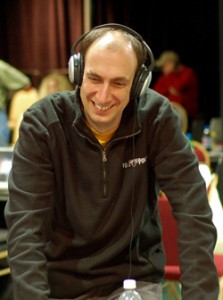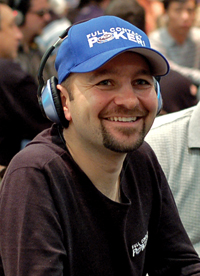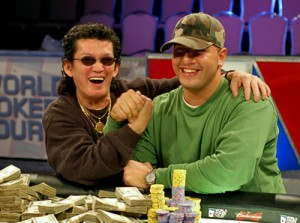 To me, Januaries and Tunica were synonymous. Every year I would prepare for my trip by stopping off at Sam’s Club for a tub of Double-Bubble and hitting the library for books on tape — anything to get me through the 10+ hour drive. It also included the annual cleaning out of my car. One year I found a cocktail glass under the passenger seat, left there from the year before by Chip Jett on a side trip to a Memphis strip club. I still have the glass, likely property of the Gold Strike.
To me, Januaries and Tunica were synonymous. Every year I would prepare for my trip by stopping off at Sam’s Club for a tub of Double-Bubble and hitting the library for books on tape — anything to get me through the 10+ hour drive. It also included the annual cleaning out of my car. One year I found a cocktail glass under the passenger seat, left there from the year before by Chip Jett on a side trip to a Memphis strip club. I still have the glass, likely property of the Gold Strike.
If you weren’t a poker player, you’d probably have to be put on a morphine drip to go to Tunica. It was basically built on Mississippi swamp land. And other than the casinos, the biggest thing in town was the Piggly Wiggly.
But for poker players, Tunica used to issue a siren’s call each year that was too loud to ignore.
These days, it’s barely a whisper.
Pauly emailed me last week. He had one question: “What the fuck happened to Tunica?” I know he’s since written about it — but I thought I still owed him an answer.
After Becky wrested 99% control of the Horseshoe in Vegas from her brother Jack, he set up his own shop. The Horseshoe in Tunica was part of the house that Jack built. And true to his roots, it was always a good room for poker. In 2000, Jack hosted the first World Poker Open, sporting a $5K buy-in Main Event. At the time, it was the second biggest buy-in after the WSOP. Since the Horseshoe was short on space, Jack partnered with the nearby Gold Strike, which had a serviceable ballroom and a solid poker room of its own. Ron Williams beat Todd Brunson for the bracelet that year. In 2001, John Juanda emerged to win the event from the 146 player starting field.
 The event had been held in the spring, but in 2002 Jack moved it to January and bumped up the buy-in to $10K. Humberto Brenes vanquished Erik Seidel for the title. And perhaps less noteworthy, it was also the year I played my first WPO event – my first major event. Tournament room rates were cheap. And the tournament set out free, lavish player buffets to die for. I never paid for a meal once I entered the casino.
The event had been held in the spring, but in 2002 Jack moved it to January and bumped up the buy-in to $10K. Humberto Brenes vanquished Erik Seidel for the title. And perhaps less noteworthy, it was also the year I played my first WPO event – my first major event. Tournament room rates were cheap. And the tournament set out free, lavish player buffets to die for. I never paid for a meal once I entered the casino.
I went back again in 2003, when the WPT picked up the event for its debut season. Dave “Devilfish” Ulliott took it down, with a young Phil Ivey finishing in second place. Only eight months earlier, Ivey had stunned the poker world by winning three WSOP bracelets. 2003 was also the year I met many of the pokerboyz, the mainstay of my poker road buddies. I also met Lou Krieger in Tunica that year. It was the year when MJ convinced me to always wear my Stetson. (Congrats on the Borgata MJ!) And I would guess that 90% of the pros I know, I first met in Tunica.
 I was in Tunica in 2004, when it would be Barry Greenstein’s turn at the title. By then the main event field had grown to 367 players. The preliminary events were humming. And players flew in from every corner of the country to tap into some of the richest cash games outside of Vegas. Some of the best tournament directors and poker room managers got their start in Tunica. Johnny Grooms, Jimmy Summerfeld, Kenny Lambert, and Jack Effel all did their time on the banks of the Big Muddy.
I was in Tunica in 2004, when it would be Barry Greenstein’s turn at the title. By then the main event field had grown to 367 players. The preliminary events were humming. And players flew in from every corner of the country to tap into some of the richest cash games outside of Vegas. Some of the best tournament directors and poker room managers got their start in Tunica. Johnny Grooms, Jimmy Summerfeld, Kenny Lambert, and Jack Effel all did their time on the banks of the Big Muddy.
But after the 2004 WPO, Jack sold the Horsehoe to Harrah’s. The 2005 WPO still went on as planned, attracting 512 starters for the Main Event. John Stoltzman took it down, with Chau Giang finishing in second, and Daniel Negreanu in third. As it would turn out, the 2005 WPO would set the high water mark.
 The Gold Strike/Horseshoe alliance ended soon after when Harrah’s decided to independently host their own tournament at their Grand Casino property Tunica. They held their first Tunica Circuit event in August 2005. But in January 2006, Harrah’s decided to take their event head-to-head against the Gold Strike’s WPO.
The Gold Strike/Horseshoe alliance ended soon after when Harrah’s decided to independently host their own tournament at their Grand Casino property Tunica. They held their first Tunica Circuit event in August 2005. But in January 2006, Harrah’s decided to take their event head-to-head against the Gold Strike’s WPO.
Predictably, It was a zoo. Rooms were overbooked and overpriced. Comps were tighter. Wait lists for even $4/8 cash games were up to 10 hours long, anywhere you went. Many of the big cash game players took a pass. There was a shortage of qualified dealers. I watched a table at the Omaha hi/lo event at the Grand. I think the dealer got off nine hands in the first hour. Chopping a quartered pot was akin to rocket science. And neither Main Event came close to 2005’s WPO numbers. The 2006 WPO Main Event drew only 327 players. Scotty Nguyen edged out Michael Mizrachi for the bracelet.
 The night before the final table, a drunk, irate poker player stole a car from the valet and drove it into the lobby of the Gold Strike. It was about 2:30am and I was walking toward the lobby when it happened. I think my post about it is still here.
The night before the final table, a drunk, irate poker player stole a car from the valet and drove it into the lobby of the Gold Strike. It was about 2:30am and I was walking toward the lobby when it happened. I think my post about it is still here.
For me, it became a metaphor for what was starting to happen in Tunica. It wasn’t about the poker or the players anymore. It was about money and the senseless – and still enduring – tournament turf wars. It was breaking. And it was the last WPO I would attend.
Later that week, the 2006 Circuit Event drew only 241 players, with Daniel Negreanu winning the ring. The WPT/Travel Channel filmed the WPO and Harrah’s/ESPN filmed the Circuit event. But that was the first and last time there’d be dueling $10K TV events in Tunica. ESPN soon opted out of covering the Circuit events. And in 2007, the Circuit Event in Tunica dropped its Main Event buy-in to $5K.
 In 2006, MGM bought out the Mandalay Bay Group, which included the Gold Strike. In 2007 the WPO was down to 294 players. It was won by Brian Sumner, with Daniel Negreanu coming in second. That year, the Circuit Event, won by Dennis Perry, drew 377. The 2008 WPO was the last WPT event held at the Gold Strike. It was won by Brian Faustman, with Hoyt Corkins finishing second. The field was down to 259 players. The competing Circuit Event failed to draw even that many, with Brian Tichelman winning over a field of 180.
In 2006, MGM bought out the Mandalay Bay Group, which included the Gold Strike. In 2007 the WPO was down to 294 players. It was won by Brian Sumner, with Daniel Negreanu coming in second. That year, the Circuit Event, won by Dennis Perry, drew 377. The 2008 WPO was the last WPT event held at the Gold Strike. It was won by Brian Faustman, with Hoyt Corkins finishing second. The field was down to 259 players. The competing Circuit Event failed to draw even that many, with Brian Tichelman winning over a field of 180.
In 2009, MGM worked with the WPT to move the event from their Gold Strike property to the Beau Rivage in Biloxi.
Harrah’s wanted to go heads up with the World Poker Open. In the end, they won. They were the last January tournament standing in Tunica. Congratulations.
One Comment